With the surge in COVID cases, Karnataka government recently announced that asymptomatic or mildly symptomatic patients need not get admitted to hospitals and may only need to go into home isolation. On July 4, the Department of Health and Family Welfare issued guidelines on home isolation. Following are these guidelines, specifying which categories of patients are eligible, and the protocols for their isolation and release.
The persons who have tested COVID positive shall be permitted to be in “home isolation” on meeting the following conditions:
- Only those who are asymptomatic or mild symptomatic shall be allowed to be in isolation at home
- They shall be oriented to the protocol of home isolation
- The health team from district health authority/ BBMP/ authorised private institution/agency shall visit the house and assess the suitability of the house for home isolation and also do a triage of the person.
- A dedicated tele-monitoring link shall be established for daily follow-up of the person during the entire period of home isolationThe person shall report to the physician/ health authorities about their health status every day
- The person shall have pulse oximeter, digital thermometer and personal protective equipment (facemasks, gloves) to be used during home isolation.
- The release of the person from home isolation shall be as per the State’s existing discharge protocol for COVID-19 (mentioned later in this article). Home isolation will be with the knowledge of the family members, neighbours, treating physician and the local health authorities.
Step-by-step measures for home isolation
1. Initial assessment of person by health team at the person’s house
- After receipt of COVID-positive report, the person shall isolate themselves at home in a separate room. Health team shall visit and assess the suitability of the house for isolation of the person, and also do triage of the person.
- Ask about these symptoms: Fever, cold, cough, throat pain, difficulty breathing, etc.
- The health staff shall assess the following parameters (Triage)
- Thermal scanning for fever
- Pulse oximetry for SpO2 (blood oxygen) levels and pulse rate
- Glucometer for random blood sugar levels
- Blood pressure recording using BP apparatus
- Enquire about co-morbidities like hypertension, diabetes, obesity, thyroid disease, cancer, kidney disease including need for dialysis, heart disease, stroke, Tuberculosis. And if the person is living with HIV, immune-compromised, on steroids or immune-suppressants, etc.
- Link the person to a tele-monitoring centre for daily follow-up
- For further daily follow-up, tele-monitoring through government or private institution/agency shall be arranged as desired by the person.
2. Eligibility for Home Isolation
- The person shall be clinically assigned as an asymptomatic/mild case by the treating medical officer/ physician.
- The person should have the requisite facility at home for self-isolation and also for quarantining family contacts.
- A caregiver should be available to provide care 24×7. A regular communication link between the caregiver and hospital is a pre-requisite for the entire duration of home isolation
- Mild fever < 38° C(< 100.4° F)
- Oxygen saturation should be > 95%
- Age shall be less than 60 years
- If the person has these co-morbidities – hypertension, diabetes mellitus, obesity, thyroid disease; these should be well-managed and under good clinical control as assessed by the medical officer/physician
- Shall not have any co-morbid conditions like kidney diseases including need for dialysis, heart diseases, stroke, Tuberculosis, cancer, HIV. Shall not be immune-compromised, on steroids and immune-suppressants, etc.
- The person shall give a signed undertaking on self-isolation (Annexure-1) and follow the guidelines of home isolation.
- The person shall agree to monitor their own health (Annexure-2) and regularly inform their health status to the physician and District Surveillance Officer (DSO) for further follow up by the surveillance teams.
- Home isolation shall not be applicable for pregnant women four weeks before expected date of delivery.
3. Facility required at home for isolation
- Separate, well-ventilated room with a separate toilet for the person in isolation
- The person shall stay in the identified room and away from other persons in the home (especially the elderly and those with co-morbid conditions like hypertension, cardiovascular disease, renal disease, etc.)
If the person is not eligible for home isolation or the house is not suitable for it, then isolation at a facility (COVID Care Centre/ Dedicated COVID Healthcare Centre/ Designated COVID Hospital) is recommended.
The following criteria shall be used for shifting the person to CCC, DCHC or DCH as applicable:
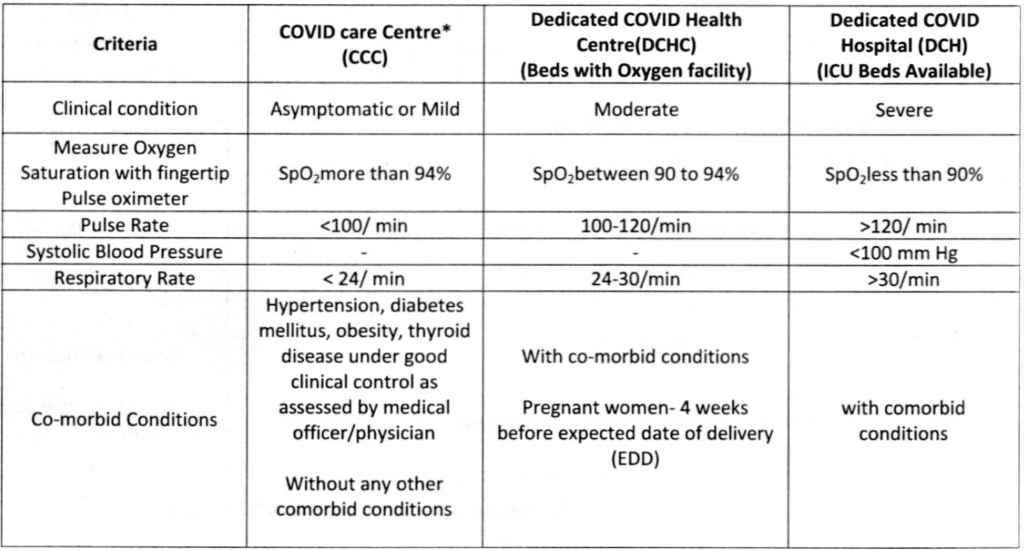
Below is the algorithm for deciding home isolation:
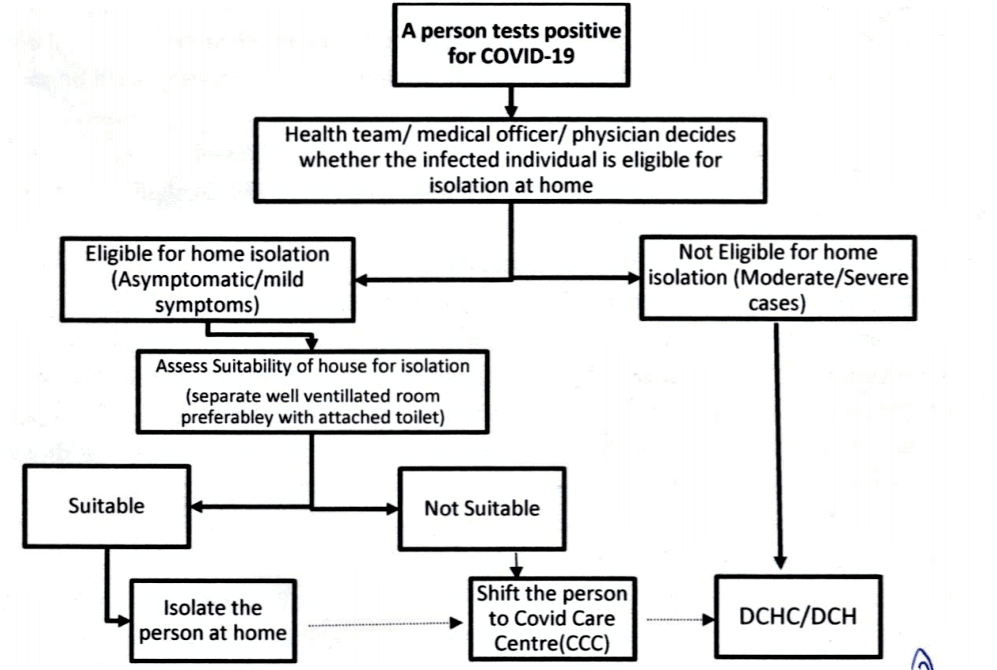
4. When to seek further medical advice
The person should immediately seek further medical advice if the following symptoms and signs develop;
- Difficulty in breathing
- Oxygen saturation < 94% using a fingertip pulse oximeter
- Persistent fever of >38° C (100.4° F) for more than 24 hours
- Persistent pain/pressure in the chest
- Mental confusion
- Slurred speech/seizures
- Weakness or numbness in any limb or of face
- Developing bluish discolouration of lips/face
- Any other symptom the person considers serious
- As advised by treating physician
5. Instructions to health staff monitoring the person in home isolation
- Ensure strict isolation of the person at home:
- Home isolation notice shall be pasted on the front door of the house.
- Hand stamping shall be done for the person in home isolation for a duration of 17 days. Quarantine Watch app shall be downloaded and used for daily monitoring.
- Inform at least two neighbours regarding home isolation of the person.
- A three-member team in the ward/ village/ booth level/ resident welfare or apartment owners’ association shall oversee the person’s compliance to home isolation.
- If the person is found violating the home isolation protocol, action will be taken under the Disaster Management Act read with the IPC, and he/she shall be shifted to CCC (COVID Care Centre).
- Link the person to a tele-monitoring centre for daily follow-up.
- IVRS outbound calls through Apthamitra helpline (14410) shall be made to the person everyday.
- The caregiver and all close contacts of the person shall take Hydroxychloroquineprophylaxis as per protocol and as prescribed by the treating medical officer/physician.
- Telephonically or using tele-monitoring mode, check the person for the development of new symptoms, fever or deterioration in oxygen saturation(<94%) at least once daily.
- Gloves, masks and other waste generated during home isolation should be placed in a closed bin in the person’s room before disposing of it as infectious waste. The disposal of infectious waste shall be the responsibility of the local municipal authority.
- Inform the neighbours to be kind to the person in isolation and his/her family, and to not stigmatise them.
- Concerned area medical officer (PHC/UPHC/CHC/GH) shall report details about patients under home isolation to DSO (District Surveillance Officer) on a daily basis. DSO should update these on GoI’s COVID-19 portal and facility app every day.
6. Instructions to the person in home isolation
- The person shall wear medical face mask/ N-95 face mask at all times. The mask shall be discarded after eight hours of use, or earlier if it becomes wet or visibly soiled.
- Mask shall be discarded only after disinfecting it with 1% sodium hypochlorite solution.
- The person must stay in the identified room only, and maintain a physical distance of 2 meters/ 6 feet from other people in the home, especially the elderly and those with co-morbid conditions like hypertension, cardiovascular disease, renal disease, etc.
- The person shall take rest and drink a lot of fluids to maintain adequate hydration. Drink at least two litres of water per day. Use boiled-and-cooled water for drinking.
- Follow cough etiquette at all times
- Wash hands often with soap and water for at least 40 seconds or clean them with an alcohol-based sanitiser.
- Do not share personal items like utensils, towels, etc., with other family members. Keep them separate.
- Clean surfaces in the room that are touched often (table-tops, doorknobs, handles, etc.) with 7% Lysol or 1% sodium hypochlorite solution.
- Clean and disinfect bathroom and toilet surfaces at least once daily. Regular household soap or detergent should be used first for cleaning, followed by l% sodium hypochlorite solution.
- The person shall strictly follow the physician’s instructions and medication advice (Annexure-3)
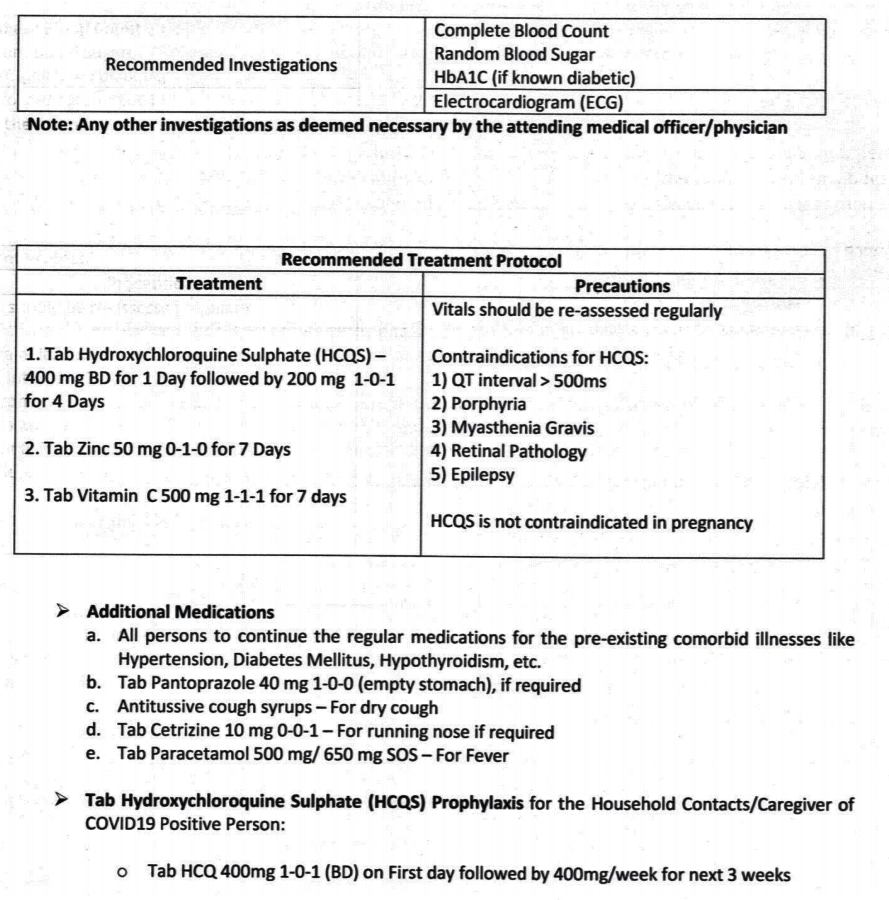
Note: The treatment protocol as by advised by your physician shall be followed
- The person shall self-monitor his/her health with a fingertip pulse oximeter and digital thermometer daily.
- The person shall report promptly if he/she develops any worsening of symptoms.
- The person shall take a healthy and nutritious diet. A model diet plan is given in annexure-4.
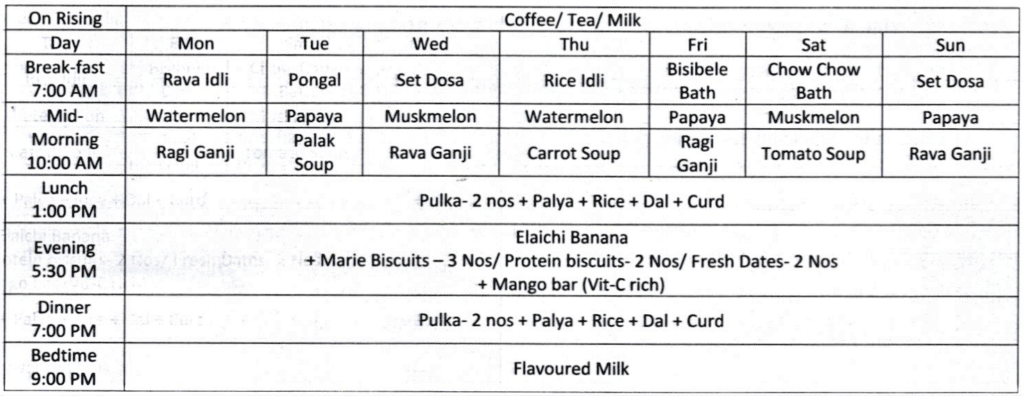
- Smoking, chewing tobacco and alcohol intake shall be strictly avoided.
- The person shall receive counselling services when necessary.
- Download Arogya Setu App on mobile; it should remain active at all times (through Bluetooth and Wi-Fi).
Do’s and Don’ts
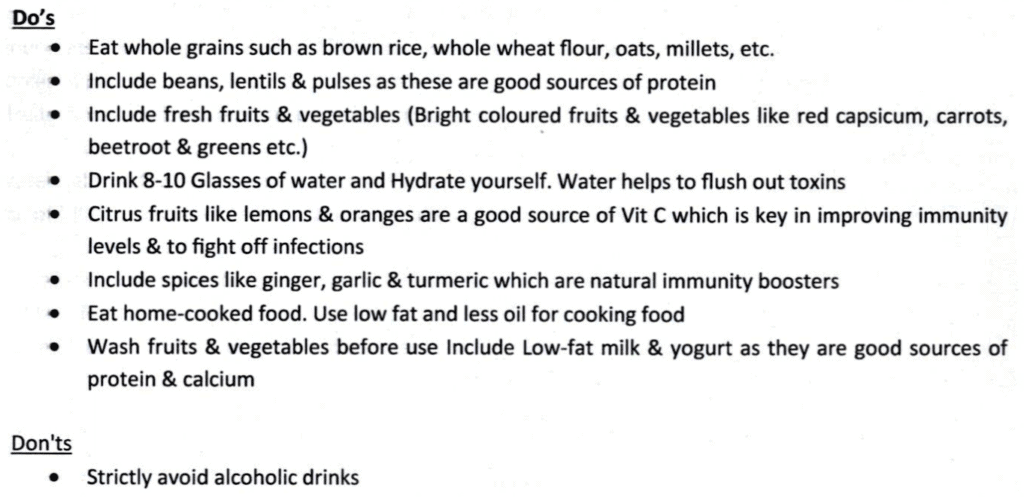
7. Instructions to caregivers
- The caregiver shall wear medical face mask/ N-95 face mask appropriately when in the same room with the ill person. The front portion of the mask should not be touched or handled during use.
- If the mask gets wet or dirty with secretions, change it immediately. Discard the mask into a separate closed bin after use, and perform hand hygiene afterwards.
- He/she shall avoid touching eyes, nose or mouth.
- Hand hygiene shall be ensured following contact with the person.
- Hand hygiene shall be practised before and after preparing food, before eating, after using the toilet, and whenever hands look dirty. Use soap and water for hand washing for at least 40 seconds. Alcohol-based hand rub can be used if hands are not visibly soiled.
- After using soap and water, use of disposable paper towels to dry hands is desirable.
- Exposure to ill person: Avoid direct contact with body fluids of the ill person, particularly oral or respiratory secretions. Use disposable gloves while handling the person. Perform hand hygiene before and after removing gloves.
- Avoid exposure to potentially contaminated items (e.g. avoid sharing food, utensils, dishes, drinks, used towels or bed linen).
- Food must be provided to the person in his/her room.
- Utensils and dishes used by the person shall be cleaned with soap/detergent and water, wearing gloves. The utensils and dishes may be re-used. Clean your hands after taking off gloves or handling used items.
- The ill person’s clothes, bed linen, and bath and hand towels shall be washed separately using regular laundry soap and warm water, or machine-washed at 60-90 °C (140-194 °F) with common household detergent, and sun-dried thoroughly.
- Gloves and protective clothing (e.g. plastic aprons) shall be used when cleaning surfaces or handling clothing or linen soiled with body fluids. Single-use gloves shall be used and discarded after each use. Perform hand hygiene before putting on and after removing gloves.
- The caregiver shall make sure that the person follows the prescribed treatment.
- The caregiver shall ensure counselling services to the person, whenever necessary.
- The caregiver and all close contacts shall monitor their own daily temperature, and report promptly if they develop any symptom suggestive of COVID-19 (fever, cough, cold, sore throat, difficulty in breathing, etc.)
8. Instructions to family members of the person in home isolation
- Do not panic. Do not stigmatise.
- Keep the person cheerful and boost their morale
- Ensure that the person is in strict home isolation
- Maintain a physical distance of at least 2 metres/ 6 feet
- Visitors are strictly not allowed until the person has completely recovered and has no symptoms of COVID-19
- Remember, the fight is against the disease and not the person
- For any assistance, please call Apthamitra helpline 14410
9. Instructions to neighbours of the person in home isolation
- Do not panic. Do not stigmatise.
- Support the person and his/her family by providing essential items like medicines, rations, vegetables, etc., until they are cured
- Keep a vigil on the person to ensure strict home isolation.
- Maintain a physical distance of 2 metres/6 feet.
- Remember, the fight is against the disease and not the person
- For any assistance, please call Apthamitra helpline 14410
10. When to release the person from isolation at home
- The person shall end home isolation 17 days after onset of symptoms (or date of sampling, for asymptomatic cases) and no fever for 3 days.
- They shall be released if the following criteria are met:
- No symptoms
- No fever (recorded temperature < 37.5°C or <99.5° F )
- Maintains saturation above 95%
- Respiratory rate less than 24 per minute
- There is no need for the RT-PCR/CBNAAT/True-NAT test after home isolation period.
- The person shall be allowed to resume duty only after satisfactory completion of home isolation.
- A fitness certificate shall be issued by the concerned area medical officer (PHC/UPHC/CHC/GH)/ treating physician. (Annexure-5)
- If the person in home isolation is under consultation/daily monitoring by a private hospital, the concerned private hospital shall report to the DSO regarding the person’s release from isolation.
- Disinfection of the house: After completion of home isolation, disinfect all commonly-touched surfaces and objects inside the house with 7% Lysol or 1% sodium hypochlorite solution. Spraying the 1% sodium hypochlorite solution on floors, walls above 6 feet, ceiling and open places will not provide any benefit. The floors shall be wet-mopped with common household detergent.
To view or print the annexures, click here.
[This article is based on press releases on July 4 from the Health & Family Welfare Department of the Government of Karnataka, and has been published with minimal edits.]
Excellent Services….Tq
I don’t have any symptoms related to covid. But I have dry mouth but no hospital ready to give treatment. I have given test for covid waiting for report. How can I servive
How many patients can stay at ccc, which is three bed room kitchen?
I was COVID positive and stayed in hospital for 6 days do I supposed to wash all the household things and clothes after going to home